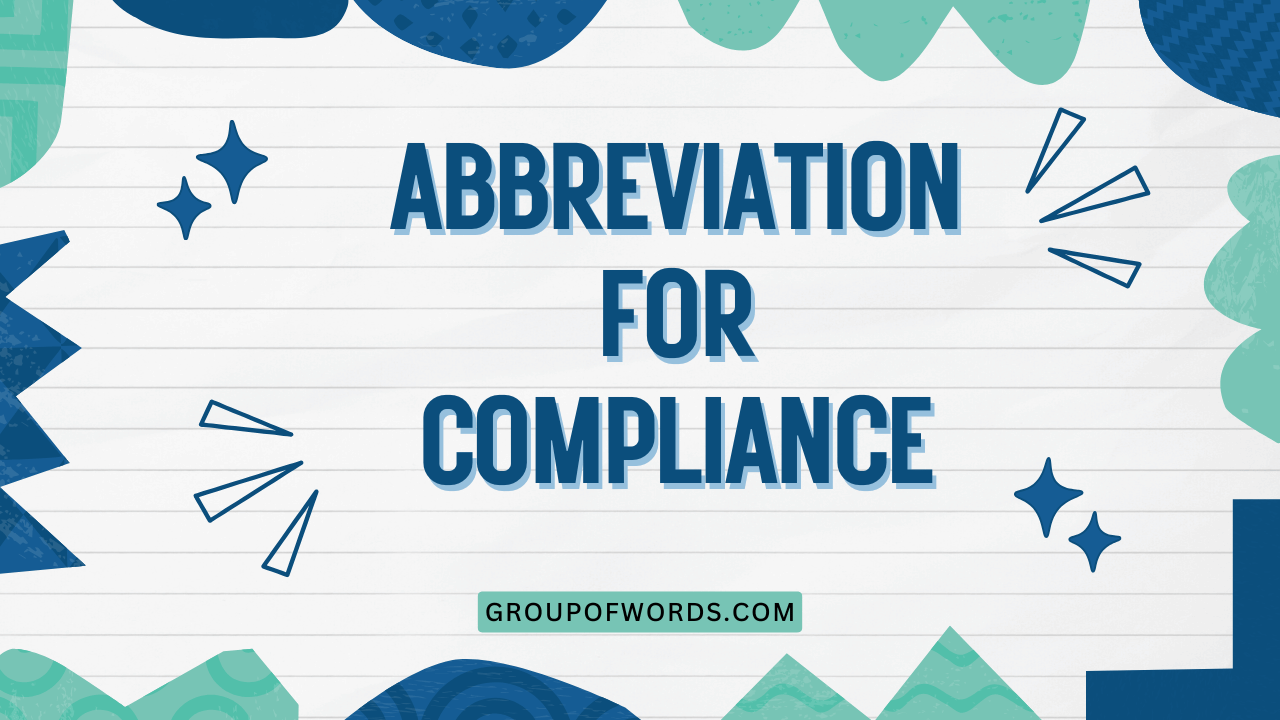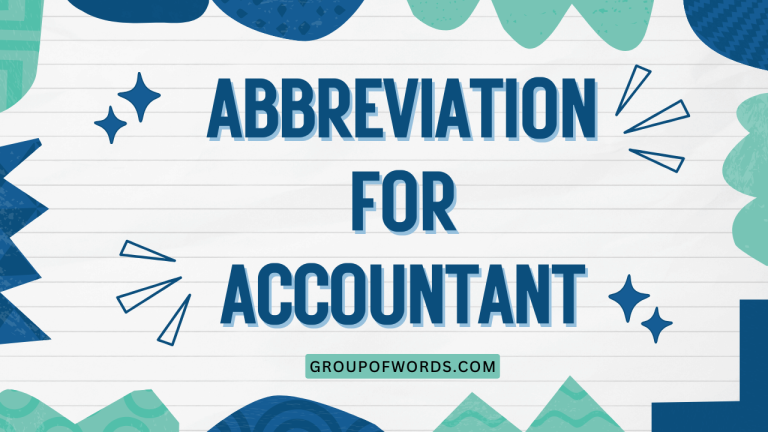Abbreviations for Compliance: A Comprehensive Guide
Understanding abbreviations for compliance is crucial in today’s regulated world. Whether you’re in business, healthcare, or any other field subject to regulatory oversight, you’ll encounter a variety of abbreviations related to compliance.
Misunderstanding these abbreviations can lead to errors, misinterpretations, and even legal issues. This article provides a comprehensive guide to common compliance abbreviations, their meanings, and their proper usage.
It is designed for professionals, students, and anyone seeking to improve their understanding of compliance-related terminology. By mastering these abbreviations, you can enhance your communication, ensure accuracy in documentation, and navigate the complexities of compliance with greater confidence.
Table of Contents
- Introduction
- Definition of Compliance Abbreviations
- Structural Breakdown of Compliance Abbreviations
- Types and Categories of Compliance Abbreviations
- Examples of Compliance Abbreviations
- Usage Rules for Compliance Abbreviations
- Common Mistakes with Compliance Abbreviations
- Practice Exercises
- Advanced Topics in Compliance Abbreviations
- Frequently Asked Questions (FAQ)
- Conclusion
Definition of Compliance Abbreviations
Compliance abbreviations are shortened forms of words or phrases related to adherence to laws, regulations, standards, and ethical practices. They are used to simplify communication, save space in documentation, and improve efficiency in various compliance-related activities.
These abbreviations can represent regulatory bodies, specific laws, compliance programs, certifications, and reporting requirements. Understanding the full meaning of these abbreviations is essential for accurate interpretation and effective communication within any industry subject to compliance mandates.
The function of compliance abbreviations is primarily to streamline communication within the field, making complex concepts easier to reference and understand at a glance. They are commonly found in legal documents, internal policies, training materials, and regulatory filings.
The context in which an abbreviation is used is often crucial for determining its specific meaning, as some abbreviations can have multiple interpretations depending on the industry or regulatory environment.
Structural Breakdown of Compliance Abbreviations
Compliance abbreviations typically follow a few common structural patterns. Many are formed by taking the first letter of each word in a phrase (e.g., HIPAA for Health Insurance Portability and Accountability Act).
Others might use a combination of the first few letters of key words or create acronyms that are pronounceable words (e.g., OSHA for Occupational Safety and Health Administration). Some abbreviations may also include numbers or symbols to further specify their meaning or reference a particular regulation or standard.
Understanding these structural patterns can help in deciphering unfamiliar abbreviations. The key structural elements include initialisms (using the first letter of each word), acronyms (forming a pronounceable word), and abbreviations that incorporate numbers or symbols.
For example, “AML” is an initialism for Anti-Money Laundering, while “FINRA” is an acronym for Financial Industry Regulatory Authority. Abbreviations like “401(k)” combine numbers and letters, indicating a specific section of the US Internal Revenue Code.
Correct capitalization is also essential when using compliance abbreviations. Generally, initialisms are written in all capital letters (e.g., GDPR), while acronyms may or may not be (e.g., FinCEN or FinCen).
Always refer to the specific style guide or regulatory guidelines relevant to your field to ensure proper capitalization.
Types and Categories of Compliance Abbreviations
Compliance abbreviations can be categorized based on what they represent. Here are some key categories:
Regulatory Bodies
These abbreviations refer to government agencies or organizations responsible for enforcing compliance with specific laws and regulations. Examples include the EPA (Environmental Protection Agency) and the FDA (Food and Drug Administration).
Laws and Regulations
These abbreviations represent specific laws, regulations, and legal frameworks that organizations must adhere to. Examples include GDPR (General Data Protection Regulation) and SOX (Sarbanes-Oxley Act).
Compliance Programs
These abbreviations denote specific programs or initiatives designed to ensure compliance within an organization. Examples include KYC (Know Your Customer) and AML (Anti-Money Laundering).
Certifications and Standards
These abbreviations refer to certifications, standards, and best practices that organizations can adopt to demonstrate compliance. Examples include ISO (International Organization for Standardization) and PCI DSS (Payment Card Industry Data Security Standard).
Reporting and Documentation
These abbreviations relate to the documentation and reporting requirements associated with compliance. Examples include SAR (Suspicious Activity Report) and SDS (Safety Data Sheet).
Examples of Compliance Abbreviations
Below are several tables with examples of compliance abbreviations, categorized by type.
Regulatory Bodies Examples
The following table provides examples of abbreviations for regulatory bodies. Understanding these abbreviations helps identify the agencies overseeing specific compliance areas.
| Abbreviation | Full Name | Description |
|---|---|---|
| EPA | Environmental Protection Agency | US agency responsible for protecting human health and the environment. |
| FDA | Food and Drug Administration | US agency responsible for regulating food, drugs, and medical devices. |
| OSHA | Occupational Safety and Health Administration | US agency responsible for workplace safety and health. |
| SEC | Securities and Exchange Commission | US agency responsible for regulating the securities markets. |
| FTC | Federal Trade Commission | US agency responsible for consumer protection and antitrust enforcement. |
| EEOC | Equal Employment Opportunity Commission | US agency responsible for enforcing laws against workplace discrimination. |
| HHS | Department of Health and Human Services | US department overseeing health-related programs. |
| DEA | Drug Enforcement Administration | US agency responsible for enforcing drug laws. |
| IRS | Internal Revenue Service | US agency responsible for tax collection and enforcement. |
| CFTC | Commodity Futures Trading Commission | US agency regulating commodity futures and options markets. |
| FINRA | Financial Industry Regulatory Authority | US non-governmental organization regulating brokerage firms and exchange markets. |
| NHTSA | National Highway Traffic Safety Administration | US agency responsible for motor vehicle safety. |
| FAA | Federal Aviation Administration | US agency regulating civil aviation. |
| FCC | Federal Communications Commission | US agency regulating communications. |
| CFPB | Consumer Financial Protection Bureau | US agency protecting consumers in the financial sector. |
| FERC | Federal Energy Regulatory Commission | US agency regulating electricity, natural gas, and oil. |
| NRC | Nuclear Regulatory Commission | US agency regulating nuclear power. |
| OFAC | Office of Foreign Assets Control | US agency administering and enforcing economic and trade sanctions. |
| OCC | Office of the Comptroller of the Currency | US agency regulating national banks. |
| BIS | Bureau of Industry and Security | US agency responsible for export controls. |
| MHRA | Medicines and Healthcare products Regulatory Agency | UK agency regulating medicines and medical devices. |
| EMA | European Medicines Agency | EU agency responsible for the scientific evaluation, supervision and safety monitoring of medicines in the EU. |
| ICO | Information Commissioner’s Office | UK’s independent authority upholding information rights in the public interest, promoting openness by public bodies and data privacy for individuals. |
Laws and Regulations Examples
The following table provides examples of abbreviations for laws and regulations. Familiarity with these abbreviations is crucial for understanding legal requirements.
| Abbreviation | Full Name | Description |
|---|---|---|
| GDPR | General Data Protection Regulation | EU regulation on data protection and privacy. |
| SOX | Sarbanes-Oxley Act | US law on corporate governance and financial reporting. |
| HIPAA | Health Insurance Portability and Accountability Act | US law on health information privacy and security. |
| FCPA | Foreign Corrupt Practices Act | US law prohibiting bribery of foreign officials. |
| AML | Anti-Money Laundering | Laws and regulations to combat money laundering. |
| KYC | Know Your Customer | Regulations requiring businesses to verify the identity of their customers. |
| BSA | Bank Secrecy Act | US law requiring financial institutions to assist government agencies in detecting and preventing money laundering. |
| FERPA | Family Educational Rights and Privacy Act | US law protecting the privacy of student education records. |
| CCPA | California Consumer Privacy Act | California law enhancing privacy rights and consumer protection for California residents. |
| GLBA | Gramm-Leach-Bliley Act | US law dealing with the privacy of consumer financial information. |
| ADA | Americans with Disabilities Act | US law prohibiting discrimination based on disability. |
| CAA | Clean Air Act | US federal law designed to control air pollution. |
| CWA | Clean Water Act | US federal law governing water pollution. |
| TSCA | Toxic Substances Control Act | US law regulating toxic chemical substances and mixtures. |
| CERCLA | Comprehensive Environmental Response, Compensation, and Liability Act | US law addressing abandoned or uncontrolled hazardous waste sites. |
| OSHA Act | Occupational Safety and Health Act | US law ensuring safe and healthful working conditions. |
| ERISA | Employee Retirement Income Security Act | US law governing employee benefit plans. |
| COBRA | Consolidated Omnibus Budget Reconciliation Act | US law providing continuation of health coverage after job loss. |
| HIPEC | The Health Information Privacy and Electronic Communications Act | Canadian laws related to protecting privacy of personal health information. |
| PIPEDA | Personal Information Protection and Electronic Documents Act | Canadian federal law concerning data privacy. |
| PIP Act | Personal Information Protection Act | Alberta’s private sector privacy law that helps to protect the privacy of Albertans. |
| CSA | Canadian Securities Administrators | The council of the securities regulators of Canada’s provinces and territories. |
| FISMA | Federal Information Security Management Act | US law that requires federal agencies to develop, document, and implement an agency-wide information security program. |
Compliance Programs Examples
The following table provides examples of abbreviations for compliance programs. Recognizing these abbreviations aids in understanding organizational compliance efforts.
| Abbreviation | Full Name | Description |
|---|---|---|
| KYC | Know Your Customer | Process for verifying the identity of customers, often in the financial industry. |
| AML | Anti-Money Laundering | Programs and procedures to prevent money laundering. |
| CDD | Customer Due Diligence | Policies and procedures to identify and verify customers. |
| EDD | Enhanced Due Diligence | Increased scrutiny for high-risk customers. |
| BCP | Business Continuity Plan | Plan for maintaining business operations during disruptions. |
| DRP | Disaster Recovery Plan | Plan for recovering IT systems and data after a disaster. |
| QMS | Quality Management System | System for managing and improving quality. |
| EMS | Environmental Management System | System for managing environmental impacts. |
| SMS | Safety Management System | System for managing safety risks. |
| ISMS | Information Security Management System | System for managing information security risks. |
| EHS | Environment, Health, and Safety | Programs and procedures for managing environmental, health, and safety risks. |
| GDP | Good Distribution Practice | Quality assurance ensuring medicinal products are consistently stored, transported and handled under suitable conditions. |
| GMP | Good Manufacturing Practice | Quality assurance that ensures that products are consistently produced and controlled according to quality standards. |
| GCP | Good Clinical Practice | An international ethical and scientific quality standard for designing, conducting, recording and reporting trials that involve the participation of human subjects. |
| SOP | Standard Operating Procedure | A set of step-by-step instructions compiled by an organization to help workers carry out complex routine operations. |
| COBIT | Control Objectives for Information and Related Technologies | A framework created by ISACA for information technology (IT) management and IT governance. |
| SOC | System and Organization Controls | A suite of service offerings CPAs may provide in connection with system-level controls of a service organization or entity-level controls of other organizations. |
| BSA/AML | Bank Secrecy Act/Anti-Money Laundering | Combined programs and procedures to comply with BSA and AML regulations. |
| SAR Filing | Suspicious Activity Report Filing | The process of filing a suspicious activity report. |
Certifications and Standards Examples
The following table provides examples of abbreviations for certifications and standards. Understanding these abbreviations helps identify the standards organizations follow to demonstrate compliance.
| Abbreviation | Full Name | Description |
|---|---|---|
| ISO | International Organization for Standardization | International standards organization. |
| PCI DSS | Payment Card Industry Data Security Standard | Security standard for organizations that handle credit card information. |
| SOC 2 | Service Organization Control 2 | Auditing procedure that ensures service providers securely manage data to protect the interests of the organization and the privacy of its clients. |
| HIPAA Security Rule | Health Insurance Portability and Accountability Act Security Rule | National standards to protect the confidentiality, integrity, and availability of electronic protected health information. |
| NIST | National Institute of Standards and Technology | A physical science laboratory and a non-regulatory agency of the United States Department of Commerce. |
| ITIL | Information Technology Infrastructure Library | A set of detailed practices for IT service management (ITSM) that focuses on aligning IT services with the needs of business. |
| COBIT | Control Objectives for Information and Related Technologies | A framework created by ISACA for information technology (IT) management and IT governance. |
| CSA STAR | Cloud Security Alliance Security, Trust & Assurance Registry | A publicly accessible registry that documents the security and privacy controls provided by various cloud computing offerings. |
| CMMI | Capability Maturity Model Integration | A process and behavioral model that helps organizations streamline process improvement and encourage productive, efficient behaviors that decrease risks in software, product and service development. |
| Six Sigma | Six Sigma | A set of techniques and tools for process improvement. |
| SAS 70 | Statement on Auditing Standards No. 70 | An auditing standard developed by the American Institute of Certified Public Accountants (AICPA) used to audit service organizations. (Now largely replaced by SOC reports). |
| ISO 9001 | ISO 9001 | International standard for quality management systems. |
| ISO 14001 | ISO 14001 | International standard for environmental management systems. |
| ISO 27001 | ISO 27001 | International standard for information security management systems. |
| OHSAS 18001 | Occupational Health and Safety Assessment Series 18001 | International standard for occupational health and safety management systems (Now replaced by ISO 45001). |
Reporting and Documentation Examples
The following table provides examples of abbreviations for reporting and documentation. Knowing these abbreviations helps in understanding the required documentation for compliance.
| Abbreviation | Full Name | Description |
|---|---|---|
| SAR | Suspicious Activity Report | Report filed with authorities regarding suspicious financial activity. |
| SDS | Safety Data Sheet | Document providing information about hazardous chemicals. |
| EHS Report | Environment, Health, and Safety Report | Report on environmental, health, and safety performance. |
| Audit Report | Audit Report | Report summarizing the findings of an audit. |
| Compliance Report | Compliance Report | Report documenting compliance efforts and status. |
| Incident Report | Incident Report | Report documenting an incident or event. |
| CAPA | Corrective and Preventive Action | Documented actions taken to correct and prevent problems. |
| SOP | Standard Operating Procedure | Documented procedures for performing tasks. |
| BIA | Business Impact Analysis | Analysis of the impact of business disruptions. |
| RA | Risk Assessment | Assessment of potential risks and vulnerabilities. |
| KPI | Key Performance Indicator | Metrics used to measure performance. |
| QMS Documentation | Quality Management System Documentation | Documents related to the quality management system. |
| EMS Documentation | Environmental Management System Documentation | Documents related to the environmental management system. |
| Training Record | Training Record | Record of training received by employees. |
| Policy Document | Policy Document | Document outlining organizational policies. |
| Procedure Manual | Procedure Manual | Manual outlining organizational procedures. |
| Form 10-K | Form 10-K | Annual report required by the U.S. Securities and Exchange Commission (SEC). |
| Form 10-Q | Form 10-Q | Quarterly report required by the U.S. Securities and Exchange Commission (SEC). |
| ESG Report | Environmental, Social, and Governance Report | Report on the company’s environmental, social, and governance performance. |
| CSR Report | Corporate Social Responsibility Report | Report on the company’s corporate social responsibility initiatives. |
Usage Rules for Compliance Abbreviations
Using compliance abbreviations correctly is crucial for clear and accurate communication. Here are some key rules to follow: Always define the abbreviation the first time it is used in a document or presentation. For example, “The General Data Protection Regulation (GDPR) sets strict rules for data privacy.” After the initial definition, you can use the abbreviation freely. Be mindful of your audience. If you are communicating with individuals who may not be familiar with compliance jargon, it is best to avoid using abbreviations or to provide a glossary of terms. Use abbreviations consistently throughout a document or presentation. Avoid switching between the full name and the abbreviation, as this can cause confusion. Check for industry-specific guidelines on abbreviation usage. Some industries have specific rules or conventions for using abbreviations. Be aware that some abbreviations have multiple meanings. The context in which the abbreviation is used will usually clarify its meaning, but it is always a good idea to double-check if there is any ambiguity. When in doubt, spell it out. If you are unsure whether your audience will understand an abbreviation, it is always best to use the full name. Maintain a glossary of abbreviations for internal use. This can help to ensure consistency and clarity in communication within your organization. Avoid using abbreviations in formal legal documents unless absolutely necessary. In these cases, it is best to use the full name to avoid any ambiguity. Ensure that the abbreviations you use are accurate and up-to-date. Compliance regulations and terminology can change over time, so it is important to stay informed.
Common Mistakes with Compliance Abbreviations
Several common mistakes can occur when using compliance abbreviations. Here are a few examples:
- Not defining the abbreviation: Assuming everyone knows what an abbreviation means can lead to confusion. Always define it on first use.
- Using the wrong abbreviation: Some abbreviations are similar but have different meanings. Double-check accuracy.
- Inconsistent usage: Switching between the full name and the abbreviation within the same document creates confusion.
- Ignoring capitalization rules: Incorrect capitalization can change the meaning or make the abbreviation unrecognizable.
- Using abbreviations in formal legal documents: This can create ambiguity and should be avoided unless necessary.
Here are some specific examples of correct vs. incorrect usage:
| Incorrect | Correct |
|---|---|
| We need to be GDPR compliant. | We need to be compliant with the General Data Protection Regulation (GDPR). |
| The company follows HIPPA guidelines. | The company follows HIPAA guidelines. |
| Our AML program is strong, Anti-Money Laundering helps prevent fraud. | Our Anti-Money Laundering (AML) program is strong. AML helps prevent fraud. |
| The SAR was filed. | The Suspicious Activity Report (SAR) was filed. |
| We must follow OSHA. | We must follow the Occupational Safety and Health Administration (OSHA) guidelines. |
Practice Exercises
Test your knowledge of compliance abbreviations with the following exercises.
Exercise 1: Matching
Match the abbreviation with its full name.
| Abbreviation | Full Name |
|---|---|
| 1. GDPR | A. Securities and Exchange Commission |
| 2. FDA | B. Occupational Safety and Health Administration |
| 3. OSHA | C. General Data Protection Regulation |
| 4. SEC | D. Food and Drug Administration |
| 5. AML | E. Anti-Money Laundering |
Answers: 1-C, 2-D, 3-B, 4-A, 5-E
Exercise 2: Fill in the Blanks
Fill in the blanks with the correct abbreviation.
- The ________ is responsible for workplace safety.
- The ________ regulates the securities markets.
- ________ is an EU regulation on data protection.
- We need to file a ________ if we suspect money laundering.
- The ________ regulates food and drugs.
- The ________ act helps protect consumers.
- Our ________ program helps us serve our customers better.
- ________ is required by financial institutions to prevent money laundering.
- The ________ sets standards for quality management.
- The ________ is the US agency that enforces food safety.
Answers: 1. OSHA, 2. SEC, 3. GDPR, 4. SAR, 5. FDA, 6. FTC, 7. KYC, 8. AML, 9. ISO, 10. FDA
Exercise 3: True or False
Determine whether the following statements are true or false.
- HIPAA protects health information privacy. (True/False)
- SOX applies to environmental regulations. (True/False)
- KYC is a type of anti-money laundering program. (True/False)
- SDS provides information about hazardous chemicals. (True/False)
- The EPA regulates financial institutions. (True/False)
- GDPR applies only to US companies. (True/False)
- OSHA is responsible for consumer protection. (True/False)
- AML stands for Anti-Malware Legislation. (True/False)
- ISO sets standards for various industries. (True/False)
- SAR stands for Savings Account Report. (True/False)
Answers: 1. True, 2. False, 3. True, 4. True, 5. False, 6. False, 7. False, 8. False, 9. True, 10. False
Exercise 4: Multiple Choice
Choose the correct answer for each question.
- What does FCPA stand for?
- (a) Federal Consumer Protection Act
- (b) Foreign Corrupt Practices Act
- (c) Financial Crimes Prevention Act
- Which organization sets standards for information security management systems?
- (a) EPA
- (b) ISO
- (c) OSHA
- What is the purpose of a SAR?
- (a) To report suspicious financial activity
- (b) To document employee training
- (c) To track environmental impact
- Which of the following is NOT a function of the FDA?
- (a) Regulating food
- (b) Regulating drugs
- (c) Regulating workplace safety
- Which law protects student educational records?
- (a) HIPAA
- (b) FERPA
- (c) SOX
Answers: 1. b, 2. b, 3. a, 4. c, 5. b
Advanced Topics in Compliance Abbreviations
For advanced learners, understanding the nuances of compliance abbreviations is essential. This includes recognizing how abbreviations can evolve over time, especially as new regulations are introduced or existing ones are updated.
Moreover, the same abbreviation can have different meanings across different industries or jurisdictions. For instance, “IRB” might refer to an Institutional Review Board in healthcare but have a different meaning in another sector.
Staying current with industry-specific glossaries and regulatory updates is crucial. Furthermore, understanding the legal implications of using or misinterpreting compliance abbreviations is vital.
Incorrectly documenting or communicating compliance information can lead to legal liabilities and penalties. Therefore, professionals in compliance roles must maintain a thorough understanding of the relevant abbreviations and their proper context.
Advanced topics also include the use of abbreviations in international compliance frameworks, which often involve a mix of local and international standards. Navigating these complexities requires a deep understanding of both the abbreviations and the underlying regulatory principles.
Frequently Asked Questions (FAQ)
- Why is it important to understand compliance abbreviations?
Understanding compliance abbreviations is crucial for accurate communication, avoiding misinterpretations, and ensuring adherence to regulatory requirements. Misunderstanding an abbreviation could lead to non-compliance, fines, or legal issues.
- Where can I find a comprehensive list of compliance abbreviations?
Comprehensive lists can be found in industry-specific glossaries, regulatory agency websites (e.g., the FDA, EPA, SEC), and compliance training materials. Online resources like specialized dictionaries and databases can also be helpful. Consider subscribing to industry newsletters and publications that regularly update compliance terminology.
- How often do compliance abbreviations change?
Compliance abbreviations can change as new regulations are introduced, existing regulations are updated, or new industry standards are developed. Stay informed by regularly reviewing regulatory updates and industry publications.
- Are compliance abbreviations universal across all industries?
No, compliance abbreviations are not universal. The same abbreviation can have different meanings in different industries. Always consider the context in which the abbreviation is used.
- What should I do if I encounter an unfamiliar compliance abbreviation?
If you encounter an unfamiliar abbreviation, consult industry-specific glossaries, regulatory agency websites, or ask a compliance expert for clarification. Always prioritize accuracy over guessing.
- Is it acceptable to create my own compliance abbreviations within my organization?
While you can create internal abbreviations, it’s crucial to define them clearly and consistently within your organization. Ensure that these abbreviations do not conflict with standard industry abbreviations and are well-documented in internal glossaries or training materials. However, avoid using them in external communications without proper definition.
- What are the potential consequences of misinterpreting a compliance abbreviation?
Misinterpreting a compliance abbreviation can lead to errors in documentation, non-compliance with regulations, financial penalties, legal liabilities, and reputational damage. Proper training and due diligence are essential to mitigate these risks.
- How can I ensure that I am using compliance abbreviations correctly?
To ensure correct usage, always define abbreviations upon first use, consult industry-specific guidelines, stay updated on regulatory changes, and seek clarification when unsure. Regular training and review of compliance materials are also beneficial.
Conclusion
Mastering compliance abbreviations is essential for anyone working in regulated industries. This article has provided a comprehensive overview of common compliance abbreviations, their meanings, and their proper usage.
By understanding the different types of abbreviations, following usage rules, avoiding common mistakes, and staying informed about industry-specific updates, you can enhance your communication, ensure accuracy in documentation, and navigate the complexities of compliance with greater confidence. Remember to always define abbreviations on first use, especially when communicating with a broad audience.
Continuous learning and attention to detail are key to maintaining compliance in an ever-evolving regulatory landscape. Embrace the challenge and make compliance abbreviations a valuable part of your professional skillset.






